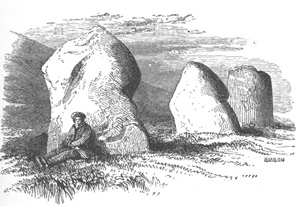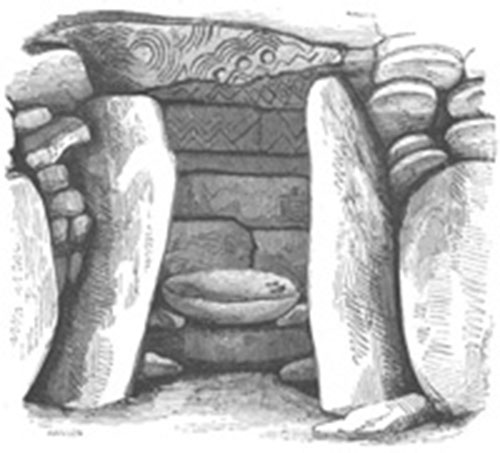New Grange - Irish Pictures (1888)
From Irish Pictures Drawn with Pen and Pencil (1888) by Richard Lovett
Chapter III: The Valley of the Boyne … continued
« Previous Page | Start of Chapter | Book Contents | Next Page »
Dowth was opened and examined in 1847, and it was soon made manifest that it was a great tomb; but nothing was unearthed or discovered superior to what had been accessible, for many years in the mound of New Grange, a mile or two nearer Slane. This consists of an enormous cairn of stones upwards of 70 feet high, covering from one to two acres, and weighing, it has been computed, 180,000 tons. Once it was surrounded by a circle of huge stones, but only ten of these remain. At intervals excavations for road making or building purposes have been made in its sides, reducing its bulk. It is not known when or by whom the entrance was first discovered and explored, but as early as 1699 a description of it was written, which agrees in all essential particulars with what any visitor can now see. The entrance is by a low passage, which starts from an enormous stone, 10 feet long, 18 inches thick, and finely carved with a bold spiral pattern. The passage runs nearly north and south, and is 63 feet long. It is constructed of upright stones, twenty-one on the right and twenty-two on the left side, covered in by great flag-stones, one of these measuring no less than seventeen feet by six. One can creep along the greater part of this passage with ease, but about 20 feet from the inner chamber the side stones have either fallen or been pressed in so as to nearly touch at the top. Here the explorer has nothing for it but to go down on hands and knees and crawl. The guide with the light who goes before proves that it can be done, and few are likely to experience any difficulty. None should allow this small drawback to prevent them from seeing a marvellous piece of work, viz:—the great sepulchral chamber, occupying the whole centre of the mound.
After squeezing through the narrow but colossal portal the way becomes easier, and we pass into a lofty domed chamber. The dim light—when we saw it a fairly strong paraffin lamp was used—the strange entrance, the outlines, at first so shadowy and awe-inspiring, all combine to make such a visit memorable. As the eye gets used to the chamber it is seen to consist of a central apartment with three recesses, one opposite the entrance, one to the east and one to the west.
One of these is depicted in our engraving. It is 9 feet high, 8 deep and 7 wide. The central chamber is formed by eleven stones, with flat surfaces facing inwards. From these as a base course, rises the dome, formed of large stones placed horizontally, each layer projecting a little beyond that directly beneath it, thus forming a structure of the 'bee-hive' type, closed and clamped at the top by an enormous slab of rock. This chamber has a diameter of 18 feet and a height of 19 feet 6 inches.
Such is the sepulchral mound of New Grange. It is impossible to stand in that weird chamber without having the brain and the imagination excited. When were these massive stones piled up with such rude and yet, for their purpose, effective skill? How did these men of a pre-Christian age acquire mechanical power sufficient to lift such masses as the roofing slab of the entrance or the keystone of the dome? What manner of men were they who could create such lordly dwellings for their dead? What ideas of life and death and the future did these mighty builders have? One would like to get the clue to these and to many such questions. But at present the answers are vague and uncertain. Not yet, with all our increased research and knowledge, have we explained the mystery. New Grange drives home upon the thoughtful observer the lesson conveyed by the old saying, 'There were kings before Agamemnon.' There were men in Ireland before historians arose to chronicle their deeds; there were conceptions of man's work and power and pride that produced these august tombs. May we not say that there is evidence here that the pre-historic man had a brain to conceive, an arm to execute, and a heart to feel, for the time in which he lived, quite equal to those of his remote nineteenth-century brother, who is apt sometimes to talk and to reason as if knowledge began with him, and as if the men of the early ages were nothing but children?
« Previous Page | Start of Chapter | Book Contents | Next Page »



